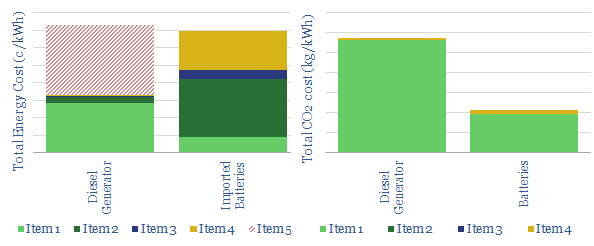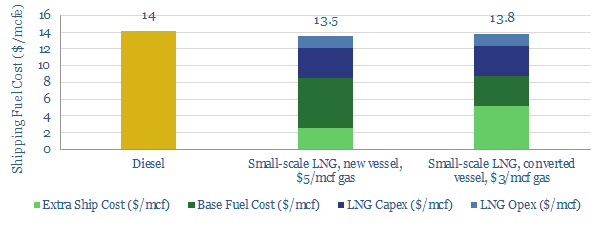
What if it were possible to displace diesel from high-cost, high-carbon “island” electricity grids, by charging up large batteries with gas- and renewable power, then shipping the batteries? This model…

…find strong economic upside for novel LNG technologies in the shipping industry, with potential to create 40-60MTpa of incremental LNG demand, looking across the global shipping fleet. Less positive on…

…shipping fuels. Dedicated LNG shipping fuels capacity should rise 20x, to 4MTpa by the end of 2021; and total shipping fuels could reach 40MTpa by 2040. Exciting projects are currently…

…shipping industry are compared and contrasted on pages 2-4, including the abatement costs of different blue and green fuels. But what about CCS? The technology is mature. However, CCS on…

…transportation, by mitigating the problem of boil-off. [restrict] What is limiting LNG in transport? LNG’s potential upside in transportation is exciting, particularly in shipping, as technologies improve and new sulphur…

…semi-subs. Elsewhere in our shipping research, we see the typical fuel consumption of a large container ship at 1400bpd, a bulk tanker at 420bpd and a LNG carrier at 270bpd….

…is summing up the economics across the entire value chain for gas production, gas processing, pipeline transportation, LNG liquefaction, LNG shipping and LNG regasification. The best projects work at $7/mcf….

…LNG demand. Upside in Shipping? The second opportunity is in LNG as a shipping fuel, which will become increasingly economical after IMO 2020 sulphur regulations re-shape the marine sector. The…

The minimum CO2 purity for CCS starts at 90%, while a typical CO2 disposal site requires 95%, CO2-EOR requires 96%, CO2 pipelines require 97% and CO2 liquefaction or shipping requires…

…ammonia fertilizer markets which does not carry any new market risk; or you can sell it as a clean fuel to decarbonize the shipping industry, which involves persuading the shipping…










